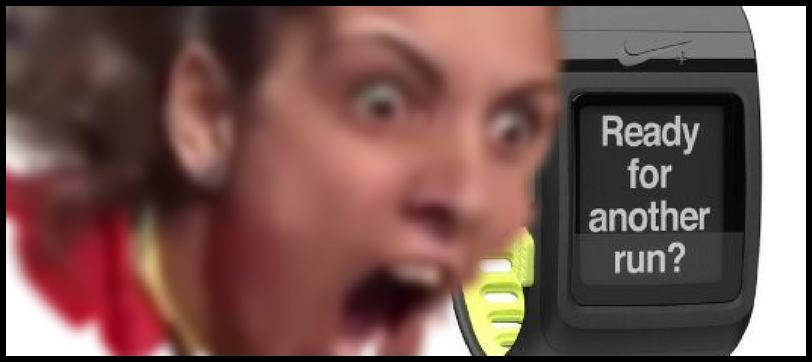Everyone loves a good running app or GPS enabled running “watch” but they can be oh so frustrating when they don’t “work”!!!
Well, according to the Garmin support centre, when your Garmin device sees “degraded performance” this is “normal behaviour”. In most cases, when you’re ready to pull you hair out because your pace readout seems to be jumping around all over the pace, or your stats for a run just don’t seem to hold true with what happened in the real world, it’s not that your device is not working. It’s more likely that your expectations of what your device can do for you, are a little on the high side.
What Garmin Says About GPS Inaccuracy
“When using a Garmin GPS fitness device in an area such as a densely wooded path or in the middle of a city with tall buildings, you may experience a longer time for the device to acquire a satellite signal. Once you’ve acquired a satellite signal you may also see a degraded performance with your GPS track as well as your running/walking pace. This is considered normal behavior since the signal being received by the device is in a weakened state.” (my emphasis)
Why Use a GPS Tracking Device At All?
Whilst I’m a fan of doing a lot of running device free, or at least running without any feedback from your device until the end of your run, there are definitely some good reasons to use a device to track your run.
- GPS training devices such as those made by Garmin, Suunto, Polar, TomTom and others can mostly give you a reasonably accurate picture of the pace and distance you ran, particularly when looking at an average pace over a longer run.
- Phone apps such as Strava, Runkeeper, Mapmyrun and Runner Up have free versions which you can download to your phone. (but the accuracy of these depend on your smartphone, and occasionally, smart phones can be pretty dumb!)
- Feedback whilst you’re running can help if you’re trying to hit a set pace for longer intervals (say 1.5-5km).
- You can learn what an “easy” pace feels like. “Easy” is often a lot slower than you realise (think 20-35% slower than your 5k race pace). Using a device to teach yourself what an easy pace feels like can be very handy.
- They are great for keeping an historical record of your training, and keeping track of your weekly mileage which you can use for future reference. If you upload data from your watch to a training log and make comments on how you felt, what the weather was like, sickness, stress etc, this info can be amazingly helpful when planning training for your next race. Over time the inaccuracies even themselves out somewhat, so you can still get a good overall picture of what’s what.
- They are a great way to quickly (and reasonably accurately) give your coach information about your training
- Having a record of your running data can be very motivating – even if all you do is record your data and keep it to yourself, for many people, this can get them out the door when they otherwise might not have. And the sharing options on most devices and apps are seemingly endless.
How Does Your GPS Device Know Where You Are?
Whether you’re using watch or phone, your device uses as its main source of location data the Global Positioning System (GPS)- a collection of 27 satellites orbiting the earth. There are 24 satellites in operation at any one time. They make two complete rotations of the earth every day
The satellites send out signals, broadcasting their location as well as the time. If a GPS receiver, like the one in your device, can locate 4 of these satellites, it can use these signals to work out your relative position to those satellites. The better your device is at picking up these signals, the more accurate the data will be. With seven or more signals, the device can know your position to within a 10 meter area.
Phones Have Additional Ways to Track You
If you have your settings right, your phone will use the GPS to track you, but it will also have a few more tricks up its sleeve. It can use WiFi location data (so if your device can see a particular hotspot, it knows you’re near that hotspot) and it also accesses Assisted GPS, (A-GPS) which uses mobile towers to keep track of GPS data so that devices don’t have to wait as long or search as hard for signals.
So What Could Possibly Go Wrong?
The GPS signals are extremely fast, and require precision detection, so any disturbance to the signal, or slight problem with reception can be magnified when it translates to your reported position.
The speed of the signal that your device sends to the satellite can be interfered with by things such as the earth’s atmosphere, buildings, trees and clouds.
- GPS signals can bounce off tall buildings. Your device assumes the signal went in a straight line, but the bounce added by the building adds some distance. This changes where your device thinks you are. Buildings can also physically block the signal from getting to your device.
- Tree cover has similar problems in that it can block the satellite signals from reaching the device. The moisture in the leaves can also cause the signals to bounce in different directions. The bounce will depend on the type of trees, how thick the cover is, and the time of year.
- Clouds: Whilst Garmin say clouds don’t impact accuracy, I’m not sure that I agree. Perhaps the clouds themselves don’t interfere, but the moisture in the air and the changes in atmospheric pressure and electrical activity often associated with cloudy days may well do so. Many runners report problems with their GPS on overcast days.
- If your phone uses ONLY Assisted-GPS to track you, the data may be less accurate. The towers and hotspots the phones connect to are in fixed positions that continuously receive data from satellites above. A smart phone’s sensor receives data from these towers. Your phone gets periodic position updates which are then averaged out, which preserves the battery of your phone, but doesn’t give you as accurate data as a tracking-dedicated device. To fix this, make sure your phone’s location setting is switched to “high accuracy” which will use GPS, Wi-Fi and local data networks to report the most accurate data.
How to Get the Most Accurate Data
There are a few tips you can follow to make your run data as accurate as possible, regardless of which app or smartphone you’re using.
- First, try to choose outdoor routes along open, relatively flat areas whenever possible. Dense, overhead foliage, tall buildings and other types of satellite or cellular interference make for greater inaccuracies.
- Avoid turns, especially tight ones, particularly if you are using a phone’s Assisted-GPS tracking capability. Because your phone is averaging location signals from cell towers; every time you change course, there’s a chance the device might miss it.
- Out-and-back routes are fine, as long as you’re only turning around once or twice, but going backwards and forwards over the same short distance is likely to cause problems.
- If you’re using a phone, have it positioned as high on your body as possible. On your arm rather than in your pocket is better. Often, cheaper arm pockets are better, as the material they are made of is thinner and might cause less interference than a thicker more robust model. Apparently issues can also arise if your phone pocket carries a lot of sweat around with it!
- Make sure your phone is set to “high accuracy so that GPS, WiFi and local mobile networks are all working for you. Go to settings in your phone. Mostly, the GPS settings can be found under “location”. Sometimes “location” is hidden in the privacy settings.
- Make sure your battery is well charged
The Stava blog has some trouble shooting advice for Android and iPhone users when it comes to GPS accuracy. A quick read is worthwhile if you’re having trouble with tracking apps on your phone.
When is a GPS device not going to cut it?
A GPS device (either one you wear on your wrist or one you use to power an app on your phone, is not going to cut it when you need to have accurate data for either training or racing.
To avoid getting inaccurate data whilst you’re racing, use the stopwatch function on your device, and manually check your pace at each km marker. This is much easier if you have a lap timer so your increasingly fatigued brain does not have to figure out your pace all on its own (possibly more inaccurate than a dodgy GPS signal- particularly in the latter stages of the race). Using your brain to figure it out is, however a spectacular way to pass the time!
In all seriousness, you shouldn’t rely on your device in a race. I’ve had too many runners come unstuck relying on inaccurate GPS devices to set their pace for them in a race. Get used to running more on feel, so you know if you are running at a pace you think you can maintain.
Yes, use your device, particularly at the start of a race when adrenalin can overtake reason and send you out way too fast, but do check in at the km markers that what your device is telling you makes sense. After the first few kms, my advice is to switch your device to a stop watch screen and run on how you’re feeling. Use the lap timer to record your splits. If you can run the GPS tracking in the background do so. Use both the GPS data and the manual km splits to analyse your race after the event.
A GPS device is also not a great idea for short speed intervals of 800m or less. You’re better off doing your speed work on a track, oval or stretch of footpath where the distance has been measured with a wheel. Time yourself with a stop watch for each effort.
Understanding the limits of your tracking device can take a whole lot of stress out of using it. Be guided by the data, but don’t be a slave to it!


